|
It's hard to imagine the first
All-Japan RC Model Helicopter Championship Contest - nearly 40 years ago. This report
from the April 1973 edition of American Aircraft Modeler has man-on-the-scene
Larry Hoffman's account of the events. There were only 22 contestants flying that
day, and all but one flew the Hueycobra made and sold by Kalt, of Tokyo. There were
no heading hold gyros or programmable transmitters with pitch and throttle curves
- just good old-fashion pilot skill and lots of body language. I certainly don't
long for those days - I can barely fly an R/C chopper with all the modern electronic
assistance - but the fortitude of the helicopter pioneers is worthy of note and
praise.
On the Scene
By Larry Hoffman
Photos by Larry Hoffman

Twenty-two fliers entered. Of these, 21 were the Japanese Kalt
Hueycobra design, each painted to look different - lotsa luck artists. It is purely
a military design.
The 26th of November, Sunday, dawned on a crispy, dry, cold, typical Japanese
winter's day with beautiful Mt. Fuji clearly visible to suburban dwellers.
After rousing my son and meeting his young friend we traveled about one hour
by train to the site of the first All-Japan RC Model Helicopter Championship Contest.
The location was the town of Irumagawa, home of the Musashi RC Model Club, situated
about forty kilometers north of Tokyo City.
Registration hit 33, but actual contestants flying numbered 22. With the exception
of one 0.0. chopper, all were a scaled-down version of Dieter Schluter's Hueycobra
made and sold by the Kalt Co., Tokyo. The 0.0. was called the "Guppy, Mark I" by
Shohei Fuji-maki of Kanagawa, Japan. Fujimaki, a leading stunt flier, tells us his
chopper houses an Enya 60 for power, weighs 4.7 kg., has a main rotor span of 1.6
meters, is controlled by a Digicon-5 radio, uses 400 cc of fuel for flights of ten
to fifteen minutes duration and has collective pitch control.
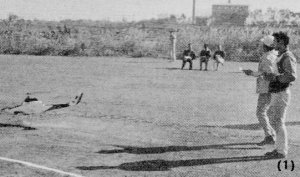
There were lots of pilot error crashes. The scene was not always as calm as shown
here. Takashi Oyamada about to begin his flight. Note the judges are well away from
the action for safety
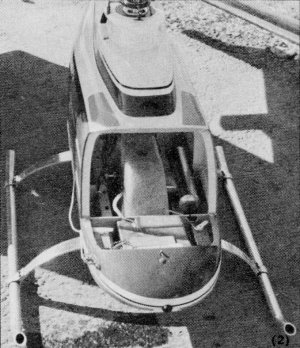
This is a Kalt helicopter but fitted with their new Jet Ranger body. Note muffler
is entirely inside.

A well-known flier, often on Japan's World Championship teams,
lsao Matsui clowns around, but did not attempt a real takeoff.
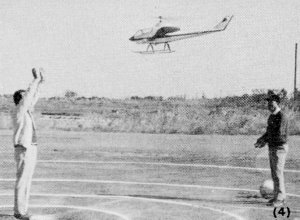
Another well-known modeler, Yuji Oki, skillfully flies his helicopter
slowly into the waiting hands of his helper. They make it look so easy.
Contest rules were quite simple:
Seven minutes for engine start and flight; Pattern consisted of (a) Takeoff at
approximately 10 to 15 degrees angle and climb out. (b) Right- or left-hand turn,
return to the starting point and a five-sec. straight flight. (c) Left turn through
360 degrees. (d) Hover for five seconds. (e) Landing pattern and off-the-spot landing.
(f) spot landing.
Two rounds were flown with the highest single score counting as the final score.
Entry fee included lunch and came to about $1.55. Trophies included one from Dieter
Schluter for the 1st place winner with trophies from the U.S. sponsored for 2nd
and 3rd. Several Japanese manufacturers put up trophies and goodies down to 7th
place.
With good weather prevailing throughout the day and the wind behaving itself,
the only crashes (and there were quite a few) were due to pilot error. As a matter
of fact, this could be called a "class" contest since all but one bird. were exactly
the same except for the paint job. It was quite interesting to note the skill levels
as the more experienced pilots took off and whipped through the maneuvers with relative
ease, leaving the others to fight various degrees of tail pitch problems, uncertain
engine vs. main rotor control, and all the other coordination difficulties that
make helicopter flying a sport for the lion-hearted.
The final scores showed the big difference between the beginning pilot and those
fortunate enough to be able to practice frequently. First place went to Kazuo Aoki
from Osaka with 1760 points; second to Takauki Nomura, from Tokyo, with 1480 points;
third-place was taken by Hisashi Ushio, also from Osaka, with 1460 points.
It might be mentioned that the fifth-place winner, Akihiro Itani, is only 16
years old. He put on a fine display of what can be done if you really put your mind
to it. For general information, young Itani's father is president of the Sankyo
Radio Co., maker of Sankyo digital control systems.
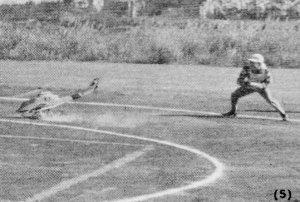
What? "Body English" in Japan? Isao Hirasawa lands acceptably
but missed the spot. He scored quite high for the flight.
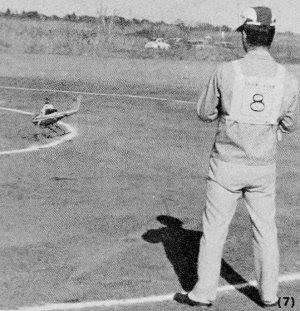
Contestant Takeshi Inoue takes off into the wind.
Posted August 28, 2019
(original 9/24/2011)
|